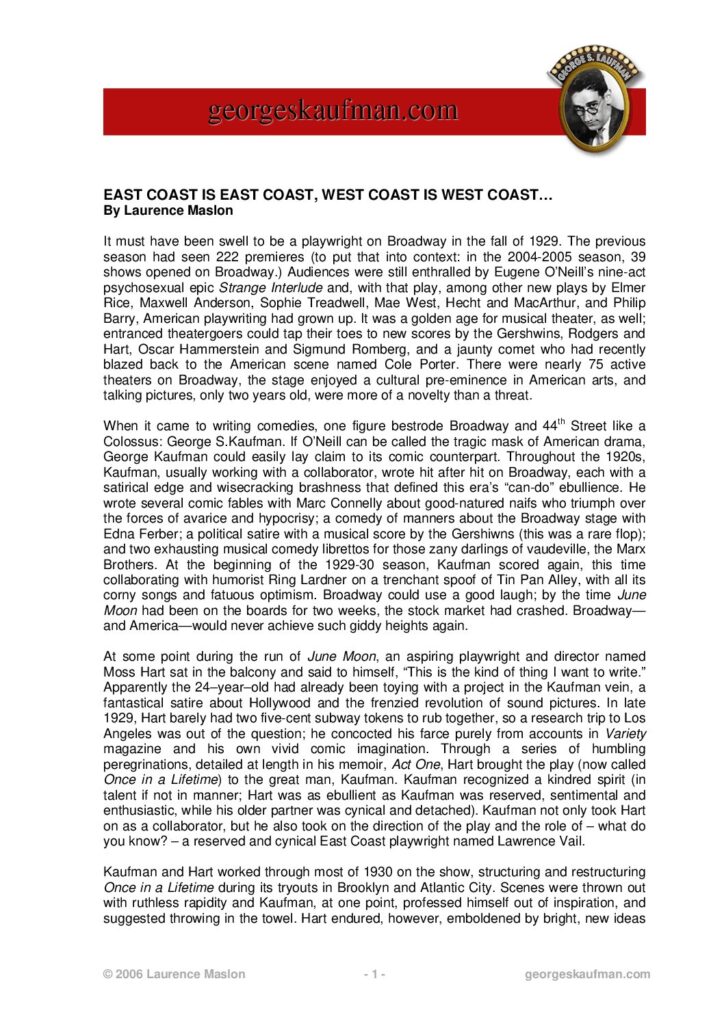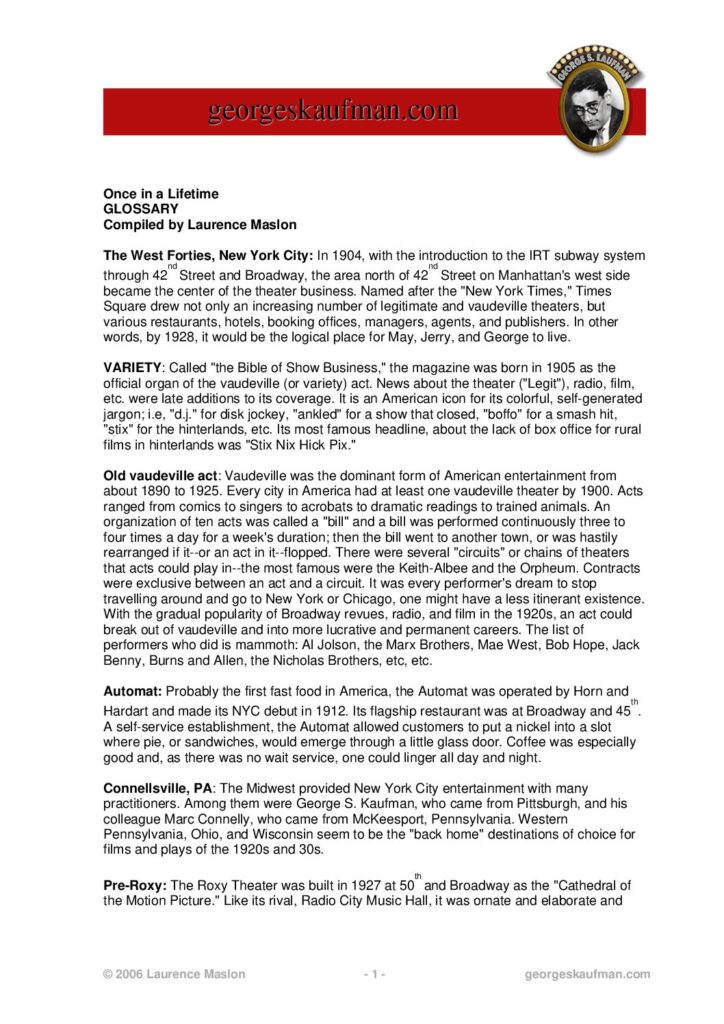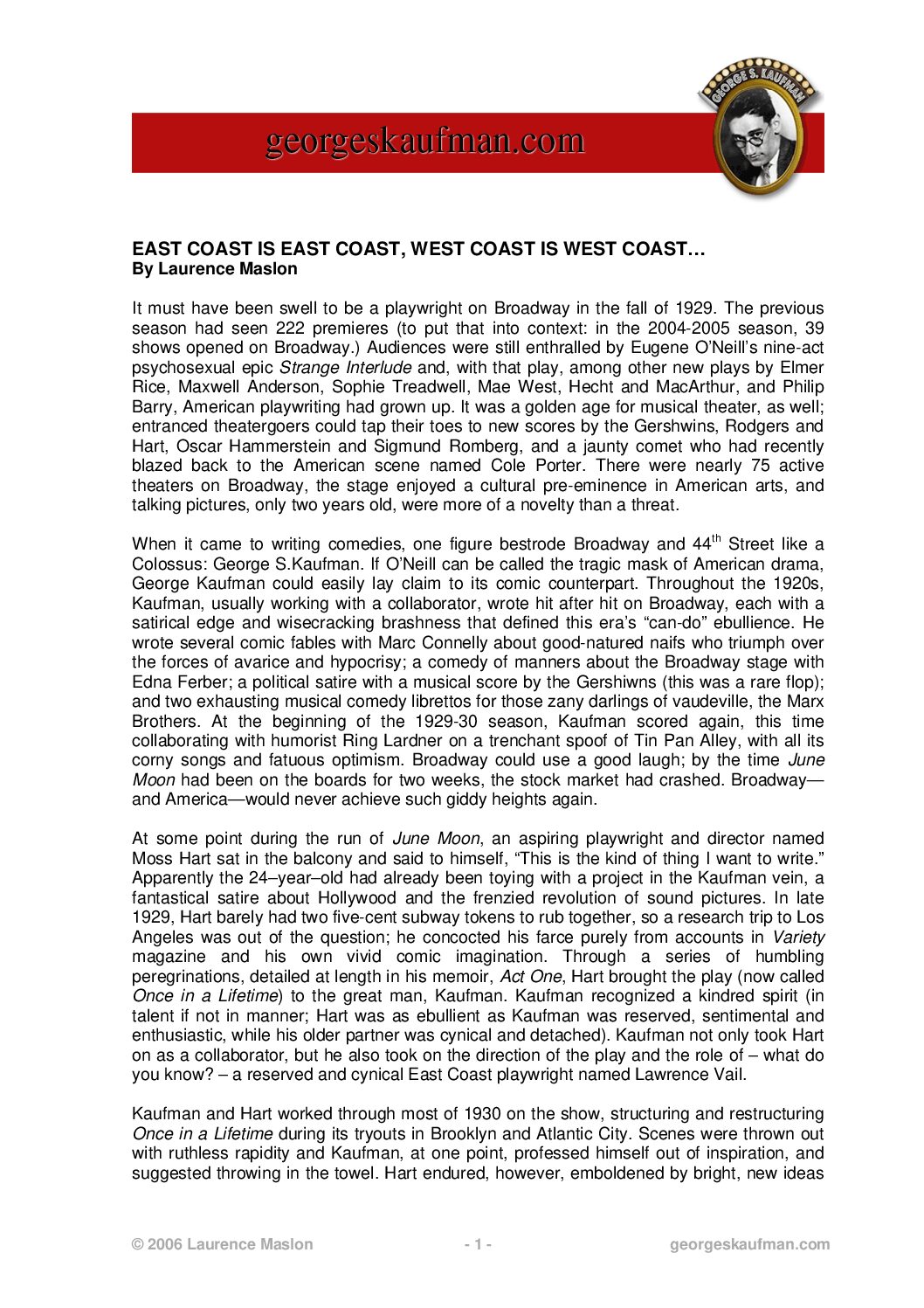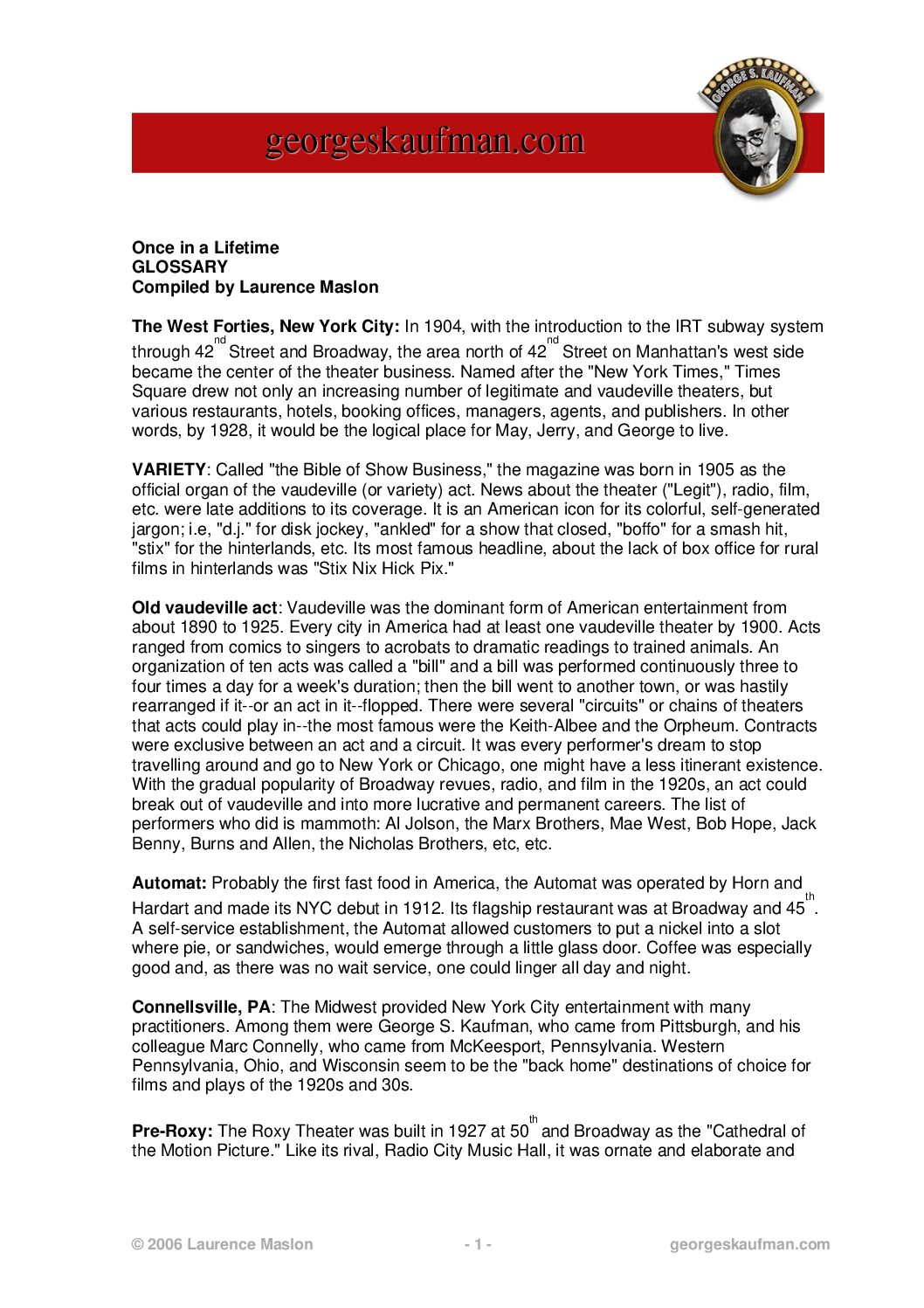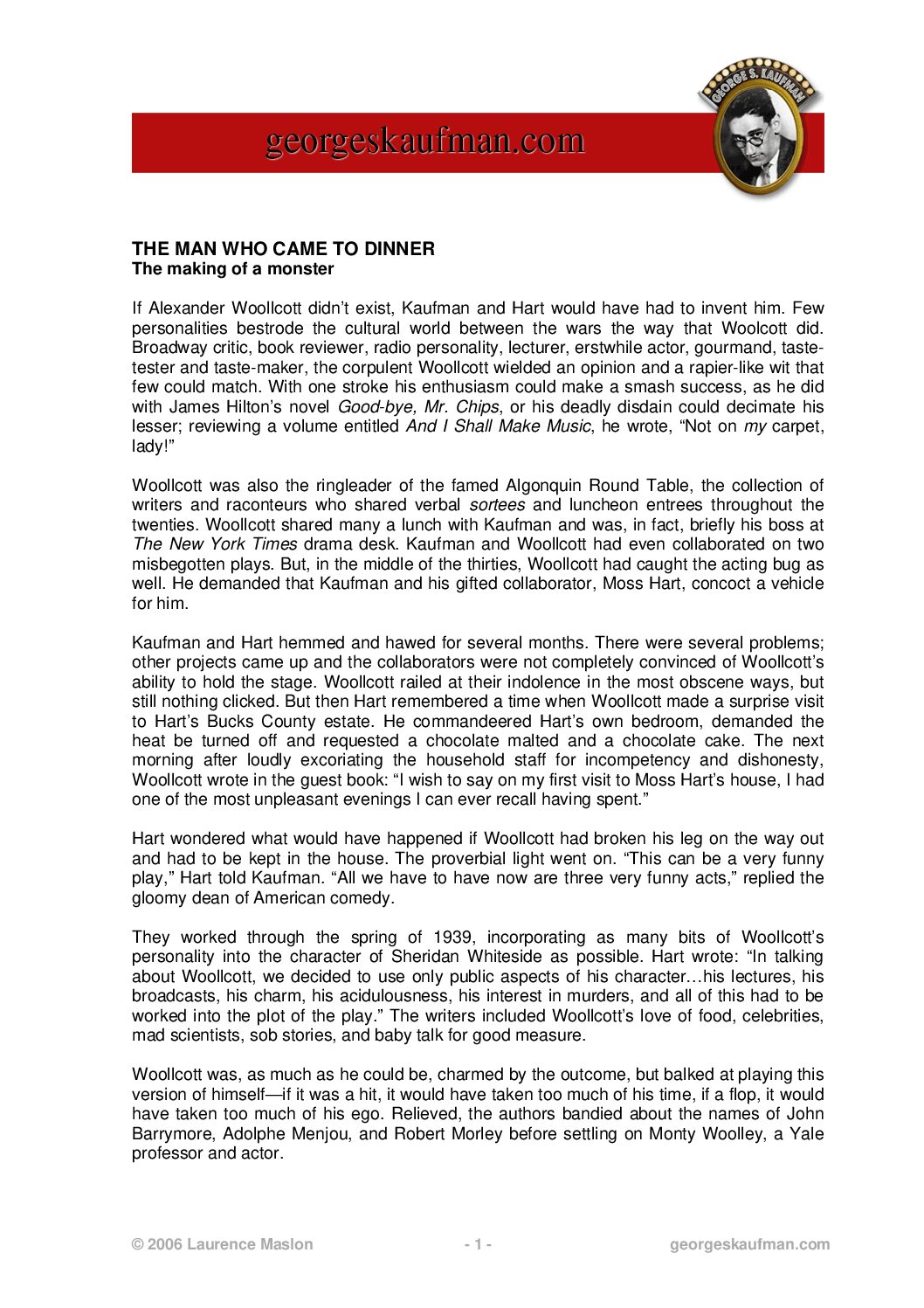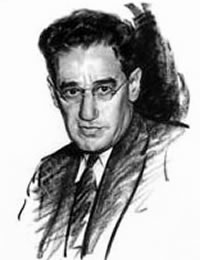June Moon – Glossary
June Moon – Glossary
From the George S. Kaufman Archive
June Moon – Glossary
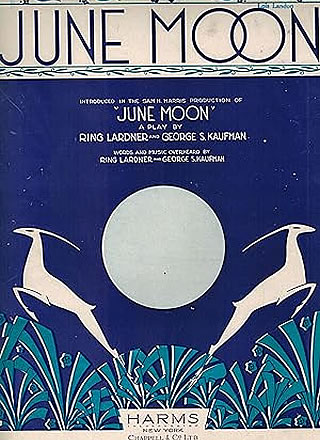 JUNE MOON
JUNE MOON
195.1 June Moon] June Moon was presented at the Broadhurst Theatre in New York on October 9, 1929. It was produced by Sam H. Harris, and Milano Tilden was the stage manager.
The cast was as follows:
FRED STEVENS: Norman Foster; EDNA BAKER: Linda Watkins; PAUL SEARS: Frank Otto; LUCILLE: Jean Dixon; EILEEN: Lee Patrick; MAXIE SCHWARTZ: Harry Rosenthal; GOLDIE: Florence D. Rice; A WINDOW CLEANER: Frank Conlan; A MAN NAMED BRAINARD: Emil Hoch; BENNY FOX: Philip Loeb; MR. HART: Leo Kennedy; MISS RIXEY: Margaret Lee.
202.26 Benny Davis] Tin Pan Alley lyricist (1895-1979) whose hits included “Baby Face” and “Margie.”
202.38-39 Friars’ Club] Created in 1904 by vaudeville performers and comedians as an alternative to the Lambs’ club.
209.30 Dillingham] Charles Dillingham (1868-1934), Broadway manager and producer.
209.31 “Nanette”] No, No, Nanette, a musical comedy, opened at the Globe Theatre on Broadway in 1925.
210.31 Dave Stamper] Stamper (1883-1963) was house composer for Florenz Ziegfeld’s
Ziegfeld Follies in the late 1910s and early 1920s.
211.14 Georgie White] George White (1890-1968), a one-time Ziegfeld dancer who began his own revue, George White’s Scandals, in 1919.
213.11 Rogers to Peet] Rogers Peet was a men’s haberdashery in Manhattan. (The 1931 Samuel French acting edition of June Moon reads “Roebuck to Sears.”)
214.6 Harms] T. B. Harms, a major Tin Pan Alley publishing house.
218.4 a popular tune] The acting edition specifies: “What Have You?”
220.38 good mechanical break] Solid sales in phonograph record or player piano roll form.
222.32 Holland Tunnel] Named after engineer Clifton Holland, a tunnel between lower Manhattan and New Jersey completed in 1927.
224.22-3 “All Those Endearing Young Charms”] Traditional Irish folk song, published by Thomas Moore in his Irish Melodies (1808-34).
231.20 “The Rosary”] 1903 devotional song, written by Georgia B. Welles and Robert Cameron Rogers.
233.14 Buddy De Sylva] George Gard “Buddy” De Sylva (1895-1950), one of Tin Pan Alley’s most successful songwriters.
233.20 “Swanee River”] Cf. “Old Folks at Home,” 1851 song by Stephen Foster.
233.23 “Show Boat”] 1927 musical by Jerome Kern and Oscar Hammerstein II.
233.26 Ruby Keeler… Duck”] Keeler (1909-93), a featured dancer in the 1928 Ziegfeld Follies and later a film actress, never appeared in Henrik Ibsen’s The Wild Duck (1884). (In the Samuel French acting edition of June Moon, the line reads “Sophie Tucker in Strange Interlude.”)
234.5-6 Gil Boag, and Earl Carroll] Gallaird T. “Gil” Boag, a nightclub owner; Earl Carroll (1892-1948), a producer, director, performer, and theater owner.
236.20 Hesperus] A ship wrecked of the Massachusetts coast in 1839, the subject of Henry Wadsworth Longfellow’s poem “The Wreck of the Hesperus” (1842).
243.1 Wayburn’s] Ned Wayburn (1874-1942), director and choreographer or musical revues for Florenz Ziegfeld and others.
244.31 Make him] The acting edition reads “Let him”.
253.19 Harry Ruby] Ruby (1895-1974), a vaudeville pianist, wrote many hit songs in the 1920s with lyricist Bert Kalmar, including “Three Little Words” and “Who’s Sorry Now?”
259.17 the Happiness boys] A vaudeville singing duo popular in the 1920s, formed by Billy Jones (1889-1940) and Ernest Hare (1883-1939).
272.5 “In a bungalow… and coo—”] In the acting edition of the play, Maxie rather than Fred sings “In a Bungalow for Two,” and each character has an additional line:
FRED. Say, that’s great. MAXIE. I thought you’d like it.
 JUNE MOON
JUNE MOON
195.1 June Moon] June Moon was presented at the Broadhurst Theatre in New York on October 9, 1929. It was produced by Sam H. Harris, and Milano Tilden was the stage manager.
The cast was as follows:
FRED STEVENS: Norman Foster; EDNA BAKER: Linda Watkins; PAUL SEARS: Frank Otto; LUCILLE: Jean Dixon; EILEEN: Lee Patrick; MAXIE SCHWARTZ: Harry Rosenthal; GOLDIE: Florence D. Rice; A WINDOW CLEANER: Frank Conlan; A MAN NAMED BRAINARD: Emil Hoch; BENNY FOX: Philip Loeb; MR. HART: Leo Kennedy; MISS RIXEY: Margaret Lee.
202.26 Benny Davis] Tin Pan Alley lyricist (1895-1979) whose hits included “Baby Face” and “Margie.”
202.38-39 Friars’ Club] Created in 1904 by vaudeville performers and comedians as an alternative to the Lambs’ club.
209.30 Dillingham] Charles Dillingham (1868-1934), Broadway manager and producer.
209.31 “Nanette”] No, No, Nanette, a musical comedy, opened at the Globe Theatre on Broadway in 1925.
210.31 Dave Stamper] Stamper (1883-1963) was house composer for Florenz Ziegfeld’s
Ziegfeld Follies in the late 1910s and early 1920s.
211.14 Georgie White] George White (1890-1968), a one-time Ziegfeld dancer who began his own revue, George White’s Scandals, in 1919.
213.11 Rogers to Peet] Rogers Peet was a men’s haberdashery in Manhattan. (The 1931 Samuel French acting edition of June Moon reads “Roebuck to Sears.”)
214.6 Harms] T. B. Harms, a major Tin Pan Alley publishing house.
218.4 a popular tune] The acting edition specifies: “What Have You?”
220.38 good mechanical break] Solid sales in phonograph record or player piano roll form.
222.32 Holland Tunnel] Named after engineer Clifton Holland, a tunnel between lower Manhattan and New Jersey completed in 1927.
224.22-3 “All Those Endearing Young Charms”] Traditional Irish folk song, published by Thomas Moore in his Irish Melodies (1808-34).
231.20 “The Rosary”] 1903 devotional song, written by Georgia B. Welles and Robert Cameron Rogers.
233.14 Buddy De Sylva] George Gard “Buddy” De Sylva (1895-1950), one of Tin Pan Alley’s most successful songwriters.
233.20 “Swanee River”] Cf. “Old Folks at Home,” 1851 song by Stephen Foster.
233.23 “Show Boat”] 1927 musical by Jerome Kern and Oscar Hammerstein II.
233.26 Ruby Keeler… Duck”] Keeler (1909-93), a featured dancer in the 1928 Ziegfeld Follies and later a film actress, never appeared in Henrik Ibsen’s The Wild Duck (1884). (In the Samuel French acting edition of June Moon, the line reads “Sophie Tucker in Strange Interlude.”)
234.5-6 Gil Boag, and Earl Carroll] Gallaird T. “Gil” Boag, a nightclub owner; Earl Carroll (1892-1948), a producer, director, performer, and theater owner.
236.20 Hesperus] A ship wrecked of the Massachusetts coast in 1839, the subject of Henry Wadsworth Longfellow’s poem “The Wreck of the Hesperus” (1842).
243.1 Wayburn’s] Ned Wayburn (1874-1942), director and choreographer or musical revues for Florenz Ziegfeld and others.
244.31 Make him] The acting edition reads “Let him”.
253.19 Harry Ruby] Ruby (1895-1974), a vaudeville pianist, wrote many hit songs in the 1920s with lyricist Bert Kalmar, including “Three Little Words” and “Who’s Sorry Now?”
259.17 the Happiness boys] A vaudeville singing duo popular in the 1920s, formed by Billy Jones (1889-1940) and Ernest Hare (1883-1939).
272.5 “In a bungalow… and coo—”] In the acting edition of the play, Maxie rather than Fred sings “In a Bungalow for Two,” and each character has an additional line:
FRED. Say, that’s great. MAXIE. I thought you’d like it.
More from the
George S. Kaufman Archive
Contact Us Today
Interested in bringing George S. Kaufman’s timeless plays to your stage?
Please refer to the contact information for each specific play on the various collection pages for direct amateur and professional licensing information.
Plays are represented by Concord Theatricals, Broadway Dramatic Licensing, and Music Theatre International respectively
If you are interested in first-class performance or film/television rights:
In the US, George S. Kaufman’s plays are represented by:
CPK Artists, LLC
In the UK, George S. Kaufman’s plays are represented by:
Alan Brodie Representation
For more information about George S. Kaufman or this website, contact:
Laurence Maslon
Literary Trustee, George S. Kaufman Estate

